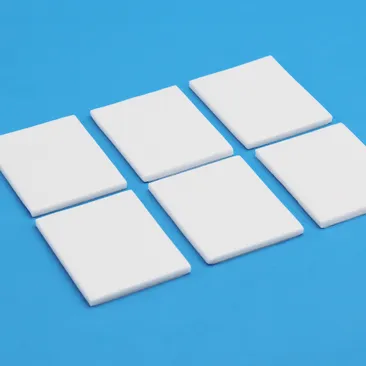Thermal Interface Materials Compare and Select
Heat is one of the most common root causes of electronic device failures, and thermal interface materials are critical to their thermal management.
This article delves into the relationship between bond line thickness (BLT), thermal conductivity (k), and thermal resistance (R″) by analyzing TIM types and common chemical compositions. It helps transform TIM selection from guesswork to a repeatable engineering process, thereby reducing thermal risks and shortening product certification cycles.

Types of Thermal Interface Materials
Understanding TIM categories and chemistries is the first step to selecting a material that fits your mechanical, thermal and manufacturability requirements.
-
Thermal Pastes / Greases (non-curing)
.webp)
BLT: 10–50 µm typical under clamping.
k: 1–12 W/m·K (varies widely).
Use: CPUs, GPUs, bench prototypes, where reworkability matters.
Pros: Very low interface R″ when thin. Cons: pump-out and potential drying over years.

Thickness: 0.3–5.0 mm, compressible 30–60%.
k: 1–15 W/m·K.
Use: Variable gaps in power modules, LED arrays, and automotive electronics.
Pros: Easy assembly, repeatable; Cons: larger R″ at thick sections.
.webp)
Behavior: Solid at room temperature; flows at ~50–65°C to fill the interface.
Use: Automated assembly needing paste-like performance without messy dispensing.
.webp)
Role: Provide both thermal conduction and permanent structural bonding.
k: 0.8–6 W/m·K typical.
Use: Ruggedized modules, sensors, parts where fasteners are unwanted.
-
Graphite Sheets & Metal Foils
.webp)
Strength: Very high in-plane k (300–1500 W/m·K) for lateral spreading; through-plane k is modest (5–20 W/m·K).
Typical chemistries and filled formulations
-
Ceramic-filled polymers (Al₂O₃, BN, AIN): electrically insulating; stable to 150–200°C. Typical k ranges: Al₂O₃ (1–3), BN (3–7), AIN (4–10 W/m·K).
-
Metal-filled systems (Ag, Cu): high k (10–40 W/m·K) but electrically conductive and costly; use where insulation is handled.
-
Polymer matrices (silicones, epoxies, polyurethanes): determine modulus, Tg and adhesion; choice affects CTE tolerance and durability.
Thermal Conductivity vs Thermal Resistance
The advertised k (W/m·K) is only half the story. The through-plane thermal impedance R″ (K·m²/W) equals thickness divided by conductivity:
R′′=t/k
and temperature rise for heat flux q (W/m²) is:
ΔT=q×R′′
Why k alone is misleading
-
Scenario: hot-spot heat flux q = 100,000 W/m² (100 kW/m²) — typical compact power die hotspot.
-
Paste example: t = 0.05 mm (0.00005 m), k = 5 W/m·K → R″ = 0.00005 / 5 = 1.0×10⁻⁵ K·m²/W → ΔT = 1.0°C.
-
Pad example: t = 0.5 mm (0.0005 m), k = 6 W/m·K → R″ ≈ 8.33×10⁻⁵ K·m²/W → ΔT ≈ 8.33°C.
Takeaway: the thicker pad gives ≈ 7.3°C higher interface temperature despite similar k — BLT dominates.
Practical rule-of-thumb and tools
-
Rule 1: If you can achieve BLT < 0.1 mm, prioritize thin TIMs (paste/PCM).
-
Rule 2: For gaps > 0.3 mm, high-k pads or filled adhesives become necessary.
-
Rule 3: Always compute R″ = t/k for candidate TIMs at expected BLT and heat flux.
Reliability, Aging & Failure Modes of Thermal Interface Materials
Long-term reliability is where TIM decisions are paid back (or regret is realized). Common failure mechanisms are predictable and testable.
Primary failure mechanisms
-
Pump-out / bleed: viscous TIMs can migrate out of the interface under thermal cycling and pressure, increasing Rth over time.
-
Compression set: pads lose compressive height (and contact pressure) after long-term stress → increasing gap and Rth.
-
Delamination: caused by CTE mismatch and cyclic shear, observed as rapid Rth growth or sudden failure.
-
Corrosion / chemical attack: acidic cure silicones or reactive residues can corrode copper or solder joints.
Symptoms: rising operating temps, hotspots on IR images, and physical shrinkage or residue.
Recommended reliability test matrix
Provide a practical test battery for qualification (example thresholds — adjust to product spec):
Test |
Condition |
Purpose |
Acceptance |
Thermal cycle |
−40°C → +125°C, 1000 cycles |
CTE / delamination |
ΔRth < 10% |
Damp heat |
85°C / 85% RH, 1000 h |
Moisture ingress |
No corrosion, ΔRth < 10% |
Vibration & shock |
Per product spec (e.g., 10–30 G) |
Mechanical adhesion |
No loosening/delam |
Compression set |
70°C, 1000 h |
Pad permanence |
Height loss < 20% |
Monitoring and in-field indicators
-
ΔRth drift: track via thermal profiling (baseline vs field).
-
Thermal imaging: periodic scans reveal new hotspots.
-
Visual inspection: check for cracking, residue, or extruded TIM.
Requalification triggers: ΔT rise > 5°C, visible delamination, or any corrosion signs.
Mitigation strategies
-
Use flexible adhesives (silicone) for CTE mismatch.
-
Implement mechanical stress relief (compliant pads, mounting springs).
-
Pre-bake or dry components where outgassing is a concern.
Selecting the Right TIM Category
Thermal Pads
-
Good for variable/large gaps and fast assembly (peel-and-place).
-
Pros: easy, repeatable, electrical insulation. Cons: thicker → higher thermal resistance; can compress over time
-
Use when gaps > 0.3 mm or when assembly speed matters.
Carbon-fiber / Graphite Pads
-
Great at spreading heat laterally. Check through-thickness (Z-axis) conductivity — in-plane numbers can be misleading.
-
Handle carefully; some are brittle.
Thermal Gels & Grease
-
Gels: dispensable, good for automation, lower stress on parts.
-
Grease: best for ultra-thin gaps (CPUs), but can pump out under cycling or vertical mounting.
Phase-Change Materials (PCM)
-
Solid at room temp, flow at ~50–60°C to form thin contact. Cleaner than paste; good where device heats enough to melt PCM.
Silicone-Free Pads
-
Use when siloxane outgassing would harm optics or sensitive contacts (LiDAR, cameras).
Reliability & Failure Modes
-
Pump-out: liquid TIM migrates out under thermal cycling → rising temps. Fix: gels, PCM, or mechanical retention.
-
Oil bleed / outgassing: low-quality silicones can contaminate optics/components. Fix: low-VOC or silicone-free TIMs and pre-bake.
-
Delamination / CTE stress: rigid adhesives can crack when materials expand differently. Fix: use flexible silicones or compliant layers.
-
Recommended tests: thermal cycling (−40→+125°C), damp-heat (85/85), compression-set, vibration. Typical pass: ΔRth < ~10%.

 English
English
 usheenthermal
usheenthermal



